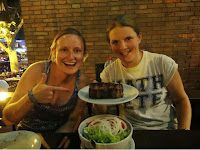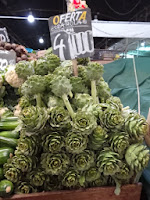 |
| At the beginning of the climb |
So we had come here to attempt to climb an active volcano. Nice. We checked into our hostel, it was just before 9am but Emma (the hostel owner) let us into the room anyway and we cleaned ourselves up and headed out to the Main Street, 'O'Higgins' to find somewhere for breakfast. As Pucon is one of those towns where early (like 5am) departures for adventure sports are the main attractions, hostels and hotels do not usually include breakfast, so we hoped to find a cafe open, but after all this is Sunday and this is South America (ie, very few things are open on Sundays). We did manage to find a cafe and had eggs and toast with more bad coffee (again, we do not understand the South American obsession with instant Nescafé). We then set out to find the volcano hiking company we (Ellen) had researched about. As in most tourist towns around the world, many companies in Pucon just want your money, they tell you that you will get to the summit and give you average quality gear, we went with Aquaventura, they have a very good safety record, they don't guarantee you will make it to the top and you do not actually pay for the adventure until you get back from the hike. They give several opportunities to back out with it costing you either nothing or just the cost of the transfer to the base of the volcano.
 |
| Villarrica |
We woke at 5am to get to the hiking office by 5.30 (it was 2 blocks away), the weather was good, a nice clear day. We were told the chairlift was not working the day we went up as it was too windy, so this added another hour onto the 4 hour hike to the top. At the top of the chairlift, after hiking an hour, single-file, up the volcanic shale we all sat down to put on our crampons, hard hats, gloves and ice picks. We then headed up the glacier. It's a hard slog, not flat at any stage, you just put your head down, watch where you put your feet, single-file hiking. At approximately each hour of hiking they stop you for a rest, you carve out a seat in the snow and ice, sit down and have a snack and get up again, after 4 and a half hours of continuous 60-90 degree angle hiking we unfortunately reluctantly gave up. We were 3/4 of the way up the volcano but the remaining quarter was to take another 2 hours and it was about a 90 degree incline, Ellen's legs had given up and Angel's feet were macerated and blistered in the rented boots you have to wear (think rigid ski boots, and try hiking in them!), our guide had told us that walking down is harder as you have to concentrate more and this when a lot of accidents happen due to fatigue (a lot of hikers have died doing this trek) so we made the sensible decision to slowly walk back. We were disappointed with ourselves but there was no way we could have made it to the top in the condition we were in, if the chairlift had have been working there may have been a possibility that we might have made it further as it would have cut out the initial hour of hiking. We'll just need to come back another time and try again! The good thing about giving up was we were able to take our time and appreciate the view, it was magnificent, and as our guide said, the views from the top were the same view as where we'd got to. We sat and ate the empanadas we had brought along for our snack and took in the breathlessly beautiful view.
The next day we decided to stay in Pucon another day, mainly because we were so tired,and Angel could barely walk with the blisters and damaged feet from the boots so we took it easy, enquired about either going rafting or to the hot springs for the additional day and strolled around the town to the 2 lakes and had lunch (an awesome breakfast burrito!) and a siesta (when in Rome) and then dinner at the best steakhouse in town, La Maga. The steak was great, Angel had a 500g bife de chorizo and Ellen had the 350g one.
We also did our laundry for probably the last time as we only have 5 days left!
We had dinner with Sarah and Brian, an Australian couple who were staying in the same hostel and Brian had done the volcano hike with us, but he had made it to the top.
The following day we went rafting! It was brilliant fun, there were some straight sections of water but the guide made it interesting but either pushing us in the water or getting us to play games so we would fall in. We had wetsuits and helmets, gloves and special shoes but the water was still cold but so clear! The group was great and the Brazilian girls are going to send us photos they took with their waterproof camera.
 |
| Our temporary dog |
We hope someone else sees her sweet nature and takes her in, or other travellers feed her. None of the strays look starving, they are all in quite good condition, but the problem here in Pucon according to the owner of the place we had lunch is that everyone wants puppies so around Christmas there is a new wave of puppies and then by late summer they are dumped. It's very sad. If we had been locals we would have kept her. Angel really does not like dogs and this one he really liked and grew attached to. Such a sweet natured dog. We called her Bob, like our cat.













































